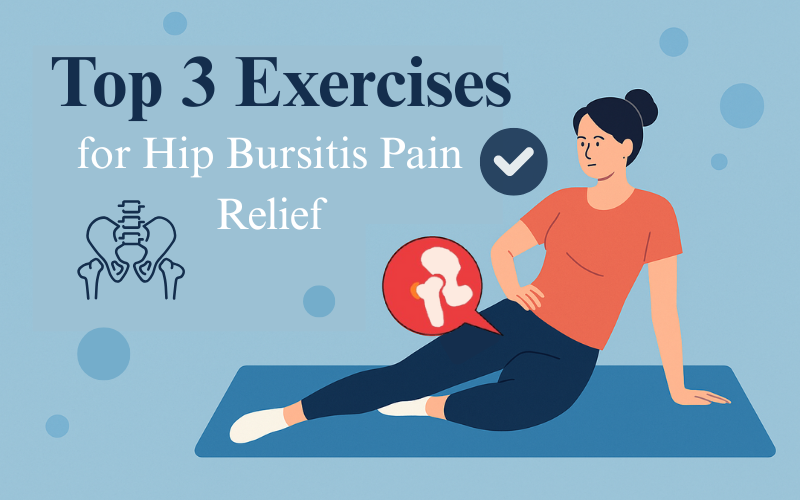If you’re looking for exercises for hip bursitis, you’re in the right place. Hip bursitis can cause sharp or aching pain on the outside of your hip, making it hard to walk, sleep, or move comfortably. The good news? Simple exercises can help reduce pain and improve how your hip feels. In this post, you’ll discover the top 3 exercises that physical therapists recommend to ease hip bursitis symptoms. Ready to move better and feel relief? Let’s get started.
Table of Contents
🚨 Looking for more information about Hip Bursitis? Check out our Understanding Trochanteric Bursitis or other related posts throughout this site.
🏁 What Is Hip Bursitis?
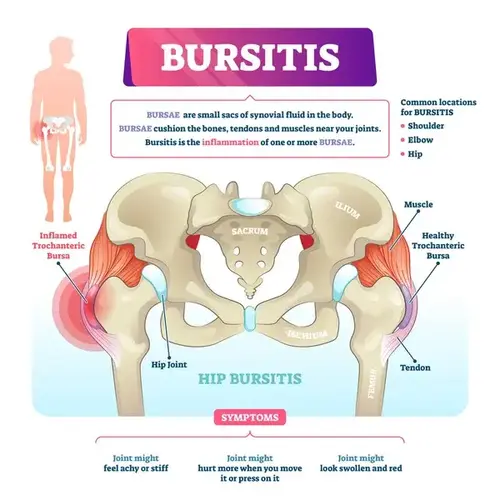
Hip bursitis is a common cause of pain on the outside of the hip. It happens when the bursa, a small fluid-filled sac that cushions your hip joint, becomes irritated or inflamed. This condition is also known as trochanteric bursitis.
There are over 150 bursae in your body, and the ones near your hip joint help reduce friction when you move. But if they’re overused or injured, they can swell and cause pain.
What Causes Hip Bursitis?
Several things can lead to bursitis in the hip, including:
- Repetitive movements like walking, running, or climbing stairs
- Poor posture or body alignment
- Previous hip injuries or surgeries
- Leg length differences
- Tight muscles around the hip
- Medical conditions like arthritis or scoliosis
What Are the Symptoms?
You might have hip bursitis if you notice:
- Sharp or aching pain on the outside of your hip
- Pain that worsens when lying on the affected side
- Tenderness when touching the outer hip
- Stiffness or discomfort during walking or climbing stairs
If any of this sounds familiar, you’re not alone. Many people struggle with hip pain daily. The good news? With the right exercises for hip bursitis, you can reduce pain and get back to moving with less discomfort.
🏆 Why Exercises Help Hip Bursitis
When dealing with hip bursitis, rest is important—but too much rest can make the pain worse. That’s where gentle movement comes in. The right exercises for hip bursitis can reduce pain, improve mobility, and help your body heal faster.
How Do Exercises Help?
- Reduce Inflammation
Low-impact exercises improve blood flow, which helps calm down swelling in the bursa. - Strengthen Supporting Muscles
Weak hip and glute muscles can put extra pressure on the bursa. Strengthening them helps take that pressure off. - Improve Flexibility
Tight muscles around your hip can rub against the bursa, causing irritation. Stretching can reduce that tension and ease pain. - Promote Better Body Mechanics
Exercises improve your posture and balance, lowering the chance of irritating your hip further during daily movement.
Are All Exercises Safe?
Not all exercises are good for hip bursitis. High-impact workouts like running or jumping may make it worse. That’s why we’ve chosen the top 3 exercises for hip bursitis that are safe, effective, and recommended by physical therapists.
Good vs. Bad Exercises for Hip Bursitis
| Good Exercises ✅ | Bad Exercises ❌ |
|---|---|
| Walking (on flat ground) | Running or Jogging |
| Clamshells | Jumping Exercises (e.g., box jumps) |
| Standing Hip Abductions | High-Intensity Interval Training (HIIT) |
| Gentle Hip Flexor or Hamstring Stretches | Deep Squats or Lunges |
| Swimming or Water Aerobics | Cycling with High Resistance |
| Bridge Exercise | Stair Climbing (excessively or too fast) |
| Side-Lying Leg Raises | Weighted Leg Lifts |
🏋️ Top 3 Physical Therapist-Recommended Exercises for Hip Bursitis
The best exercises for hip bursitis are simple, low-impact, and focus on strengthening and stretching the muscles around your hip. These movements are commonly used in physical therapy to reduce pain, improve stability, and support healing.
Do these exercises 1–2 times daily, and always move slowly and with control. Stop if you feel sharp pain.
1. Clamshell Exercise
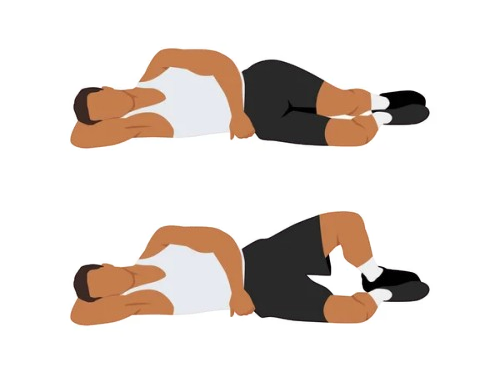
Why It Helps:
Clamshells strengthen the gluteus medius, a key muscle that supports your hip and helps reduce pressure on the inflamed bursa.
How to Do It:
- Lie on your side with knees bent and stacked, feet together.
- Keep your feet touching as you lift your top knee, like opening a clamshell.
- Don’t let your hips roll back—keep them stacked.
- Lower your knee slowly.
Reps:
2 sets of 10–15 reps per side
💡Pro Tip:
Add a resistance band around your thighs for more challenge (only if pain-free).
2. Standing Hip Abduction
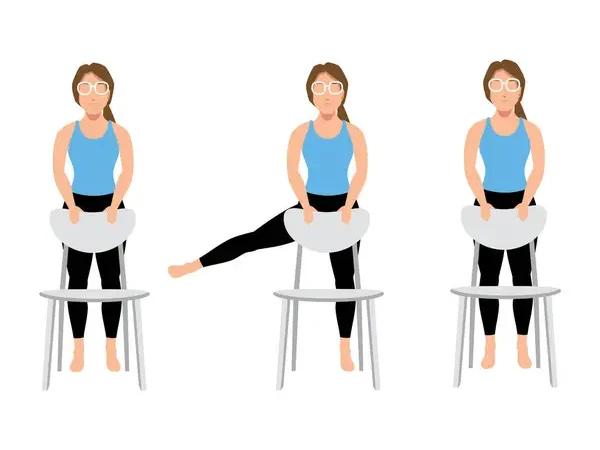
Why It Helps:
This exercise strengthens the muscles on the side of your hip, improving balance and reducing joint strain.
How to Do It:
- Stand tall, holding a chair or wall for support.
- Slowly lift one leg out to the side (keep your toes facing forward).
- Pause, then slowly return to start.
Reps:
2 sets of 10–12 reps per leg
💡Pro Tip:
Keep your back straight—don’t lean. The movement should come from your hip, not your back.
3. Hip Flexor Stretch
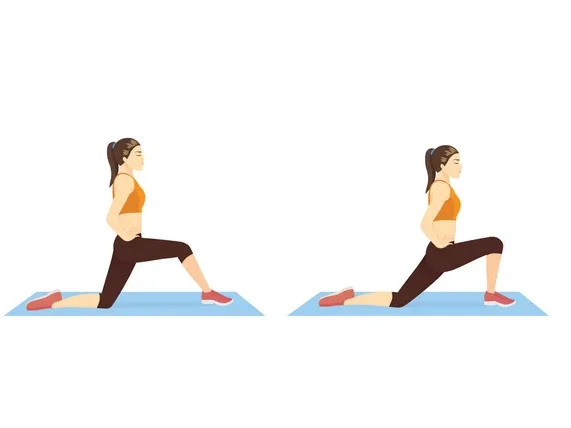
Why It Helps:
Tight hip flexors can pull on your pelvis and irritate the bursa. Stretching them gently relieves tension and improves mobility.
How to Do It:
- Kneel on one knee with the other foot in front, forming a 90° angle.
- Shift your weight slightly forward until you feel a stretch in the front of the hip (on the kneeling side).
- Hold for 20–30 seconds, then switch sides.
Reps:
2–3 stretches per side
💡Pro Tip:
Engage your core and avoid arching your lower back.
✅ Bonus Tips for Managing Hip Bursitis at Home
In addition to doing the right exercises for hip bursitis, small changes at home can make a big difference in your recovery. These tips are simple, practical, and often recommended by physical therapists to speed up healing and prevent flare-ups.
1. Apply Ice to Reduce Pain and Swelling
Use an ice pack on the outside of your hip for 15–20 minutes, 2–3 times a day, especially after activity. This helps calm inflammation and numb soreness.
💡 Tip: Wrap ice in a towel—never apply directly to skin.
2. Modify Your Daily Activities
Avoid movements that make your pain worse, like:
- ❌Standing on one leg for long periods
- ❌Walking on uneven ground
- ❌Crossing your legs while sitting
👉Use a cushion when sitting for long periods, and try to sleep on your opposite side with a pillow between your knees.
3. Try Over-the-Counter Anti-Inflammatory Options
NSAIDs (like ibuprofen or naproxen) can help reduce pain and swelling. Always check with your doctor before starting any new medication.

4. Use Supportive Gear When Needed
A cane or walking stick (used on the opposite side of your painful hip) can reduce pressure while walking. Compression sleeves, foam rollers, or orthopedic cushions may also help.
5. Stay Consistent with Your Rehab Plan
Doing your exercises daily—even just 10–15 minutes—can help you see faster results. Don’t rush or skip steps. Healing takes time, but with the right approach, it does happen.
🧑⚕️ When to See a Physical Therapist or Doctor
While many people get relief from doing exercises for hip bursitis at home, some cases need extra help. If your pain isn’t improving—or it’s getting worse—it’s time to see a professional.
See a Physical Therapist or Doctor If:
- Pain lasts more than 2–3 weeks with no improvement
- The pain keeps you up at night, even with pillows
- You notice swelling, redness, or warmth over your hip
- Walking or climbing stairs becomes difficult
- You’ve already tried exercises, but they’re not helping
A physical therapist can create a custom plan that targets your specific needs. They’ll help correct body mechanics, improve strength, and guide your recovery safely. In some cases, your doctor may recommend medications or other treatments if inflammation is severe.
🧠 Final Thoughts
Hip bursitis can make everyday movement uncomfortable—but it doesn’t have to stay that way. With the right exercises for hip bursitis and a few simple home tips, you can reduce pain, build strength, and move more freely.
Start with the 3 exercises shared in this post. Stay consistent, listen to your body, and make small changes to your daily routine. If pain continues or gets worse, don’t wait—reach out to a physical therapist or healthcare provider for extra support.
Ready to take control of your hip health?
Subscribe to our newsletter for more expert tips, rehab exercises, and stretch guides delivered straight to your inbox!


